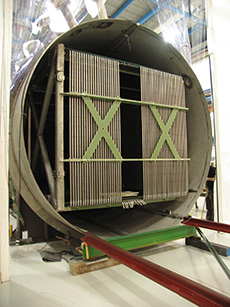Liquid-argon time projection chamber gets a test fit
 |
A 6-ton time projection chamber now sits inside the MicroBooNE cryostat. Photo: Sarah Khan
|
Recently MicroBooNE's liquid-argon time projection chamber, the largest in the United States, was successfully test-fitted inside a roughly 15-ton cryostat at the former DZero assembly building.
The process was similar to fitting a square peg into a round hole. In fact, it was exactly like that.
"We all had a few sleepless nights over this test fit, so we're glad to see that it went smoothly," said MicroBooNE construction co-manager Jennifer Raaf.
The 10-meter-long TPC's corners cleared the cryostat's sides by just a few inches. The snug fit maximizes the volume of "active" space to detect drifting electron streams that ultimately come from neutrinos.
Fermilab workers mounted the TPC on a trolley of old railroad tracks and moved it into the cryostat where it was secured. The whole process took a few hours of careful moving, said University of Cincinnati graduate student Ryan Grosso.
Inserting the TPC into the cryostat was a meticulous task, Raaf said.
"We needed to know precisely where everything would be situated in the tank," Raaf said. "The test fit is one of the things we've been dying to do."
Part of the reason for the test fit was determining whether the fragile detection wires at one end of the TPC would break during installation and operation.
The team used sample wires for the test fit to ensure that there were no interferences that could break a wire while pushing the TPC into the tank, Raaf said. Once they remove the TPC, the team will install more than 8,000 real detection wires.
Wires breaking during the detector operation could be a "huge setback," Grosso said, so they must be at the right tension when they're installed.
"We've practiced installing the wires before, but there is no room for mistakes this time," Grosso said.
The team is setting up a clean room at the cryostat's front end where the wires will be installed next month.
Assembly of the TPC started last July. Once the wires are installed, the team will be ready to permanently install the TPC.
"I'm really happy with the progress we've made so far," Raaf said.
—Sarah Khan
|